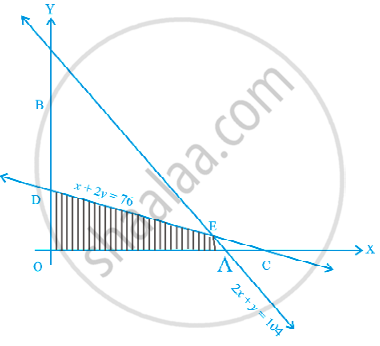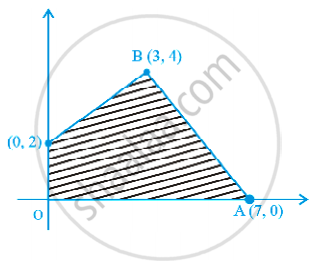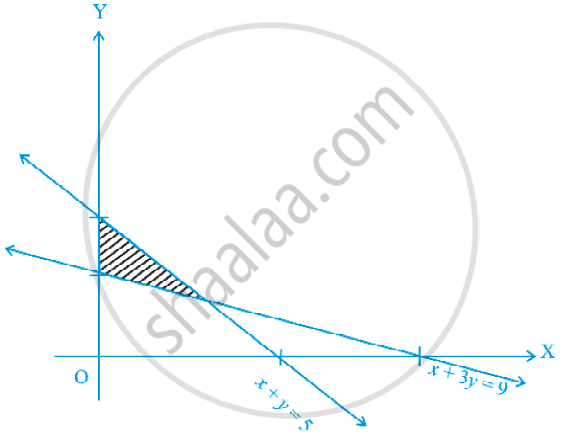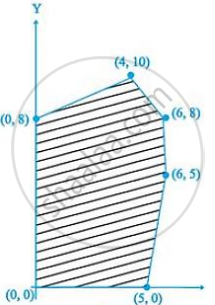Advertisements
Advertisements
प्रश्न
A manufacturer produces two Models of bikes-Model X and Model Y. Model X takes a 6 man-hours to make per unit, while Model Y takes 10 man-hours per unit. There is a total of 450 man-hour available per week. Handling and Marketing costs are Rs 2000 and Rs 1000 per unit for Models X and Y respectively. The total funds available for these purposes are Rs 80,000 per week. Profits per unit for Models X and Y are Rs 1000 and Rs 500, respectively. How many bikes of each model should the manufacturer produce so as to yield a maximum profit? Find the maximum profit.
उत्तर
Let x and y be the number of Models of bike produced by the manufacturer.
Given information is
Model X takes 6 man-hours to make per unit
Model Y takes 10 man-hours to make per unit
Total man-hours available = 450
∴ 6x + 10y ≤ 450
⇒ 3x + 5y ≤ 225 ......(i)
Handling and marketing cost of Model X and Y are ₹ 2,000 and ₹ 1,000 respectively
Total funds available is ₹ 80,000 per week
∴ 2000x + 1000y ≤ 80,000
⇒ 2x + y ≤ 80 ......(ii)
And x ≥ 80, y ≥ 0
Profit (Z) per unit of models X and Y are ₹ 1,000 and ₹ 500 respectively
So, Z = 1000x + 500y
The required LPP is
Maximise Z = 1000x + 500y subject to the constraints
3x + 5y ≤ 225 .......(i)
| x | 0 | 75 |
| y | 45 | 0 |
2x + y ≤ 80 ......(ii)
| x | 0 | 40 |
| y | 80 | 0 |
x ≥ 0, y ≥ 0 ......(iii)
On solving equation (i) and (ii)
We get, x = 25, y = 30
Here, the feasible region is OABC
Whose corner points are O(0, 0), A(40, 0), B(25, 30) and C(0, 45).
Let us evaluate the value of Z.
| Corner points | Value of Z = 1000x + 500y | |
| O(0, 0) | Z = 0 + 0 = 0 | |
| A(40, 0) | Z = 1000(40) + 0 = 40,000 | ← Maximum |
| B(25, 30) | Z = 1000(25) + 500(30) = 40,000 | ← Maximum |
| C(0, 45) | Z = 0 + 500(45) = 22500 |
Hence, the maximum profit is ₹ 40,000 by producing 25 bikes of Model X and 30 bikes of Model Y.
APPEARS IN
संबंधित प्रश्न
Show that the minimum of Z occurs at more than two points.
Minimise and Maximise Z = x + 2y
subject to x + 2y ≥ 100, 2x – y ≤ 0, 2x + y ≤ 200; x, y ≥ 0.
Show that the minimum of Z occurs at more than two points.
Maximise Z = – x + 2y, Subject to the constraints:
x ≥ 3, x + y ≥ 5, x + 2y ≥ 6, y ≥ 0.
A farmer mixes two brands P and Q of cattle feed. Brand P, costing Rs 250 per bag contains 3 units of nutritional element A, 2.5 units of element B and 2 units of element C. Brand Q costing Rs 200 per bag contains 1.5 units of nutritional elements A, 11.25 units of element B, and 3 units of element C. The minimum requirements of nutrients A, B and C are 18 units, 45 units and 24 units respectively. Determine the number of bags of each brand which should be mixed in order to produce a mixture having a minimum cost per bag? What is the minimum cost of the mixture per bag?
A dietician wishes to mix together two kinds of food X and Y in such a way that the mixture contains at least 10 units of vitamin A, 12 units of vitamin B and 8 units of vitamin C. The vitamin content of one kg food is given below:
| Food | Vitamin A | Vitamin B | Vitamin C |
| X | 1 | 2 | 3 |
| Y | 2 | 2 | 1 |
One kg of food X costs Rs 16 and one kg of food Y costs Rs 20. Find the least cost of the mixture which will produce the required diet?
Determine the maximum value of Z = 11x + 7y subject to the constraints : 2x + y ≤ 6, x ≤ 2, x ≥ 0, y ≥ 0.
Determine the maximum value of Z = 3x + 4y if the feasible region (shaded) for a LPP is shown in Figure
Feasible region (shaded) for a LPP is shown in Figure. Maximise Z = 5x + 7y.
The feasible region for a LPP is shown in Figure. Find the minimum value of Z = 11x + 7y
In figure, the feasible region (shaded) for a LPP is shown. Determine the maximum and minimum value of Z = x + 2y.
A man rides his motorcycle at the speed of 50 km/hour. He has to spend Rs 2 per km on petrol. If he rides it at a faster speed of 80 km/hour, the petrol cost increases to Rs 3 per km. He has atmost Rs 120 to spend on petrol and one hour’s time. He wishes to find the maximum distance that he can travel. Express this problem as a linear programming problem
Refer to question 14. How many sweaters of each type should the company make in a day to get a maximum profit? What is the maximum profit.
Refer to question 15. Determine the maximum distance that the man can travel.
The corner points of the feasible region determined by the system of linear constraints are (0, 0), (0, 40), (20, 40), (60, 20), (60, 0). The objective function is Z = 4x + 3y ______.
Compare the quantity in Column A and Column B
| Column A | Column B |
| Maximum of Z | 325 |
In a LPP, the objective function is always ______.
If the feasible region for a LPP is ______ then the optimal value of the objective function Z = ax + by may or may not exist.
In a LPP if the objective function Z = ax + by has the same maximum value on two corner points of the feasible region, then every point on the line segment joining these two points give the same ______ value.
A corner point of a feasible region is a point in the region which is the ______ of two boundary lines.
Maximum value of the objective function Z = ax + by in a LPP always occurs at only one corner point of the feasible region.
In the given graph, the feasible region for an LPP is shaded. The objective function Z = 2x – 3y will be minimum at:

A linear programming problem is as follows:
Minimize Z = 30x + 50y
Subject to the constraints: 3x + 5y ≥ 15, 2x + 3y ≤ 18, x ≥ 0, y ≥ 0
In the feasible region, the minimum value of Z occurs at:
Objective function of a linear programming problem is ____________.
In linear programming, optimal solution ____________.
In Corner point method for solving a linear programming problem, one finds the feasible region of the linear programming problem, determines its corner points, and evaluates the objective function Z = ax + by at each corner point. If M and m respectively be the largest and smallest values at corner points then ____________.
Maximize Z = 10×1 + 25×2, subject to 0 ≤ x1 ≤ 3, 0 ≤ x2 ≤ 3, x1 + x2 ≤ 5.
